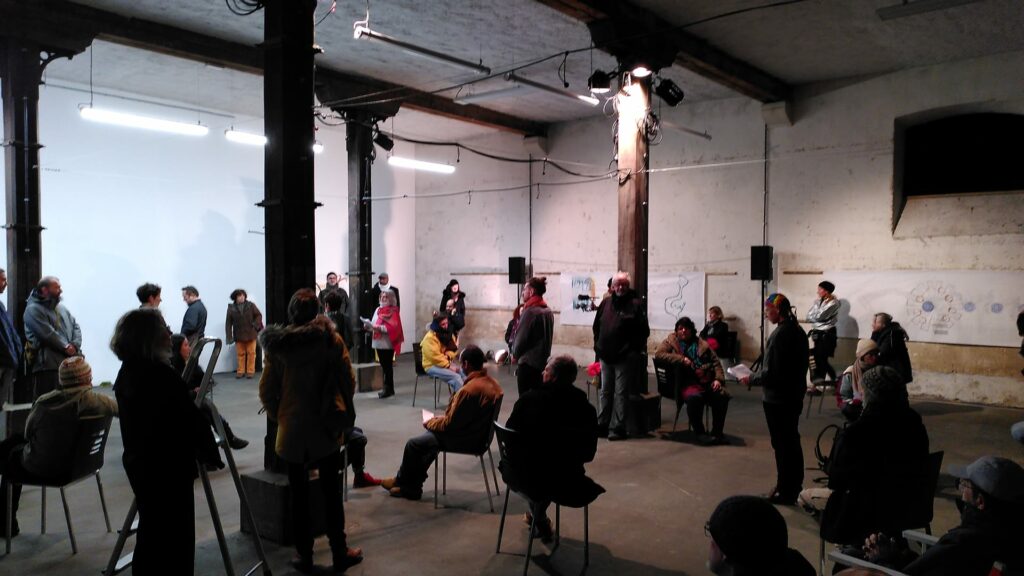This participatory and creative collaboration was commission as part of my SCDTP postdoctoral project funded through the Economic and Social Research Council of the UK.
Écoutez \\ Listen to the live recording
La Traverse, Bergerac, décembre 2024

What is the link between concrete and commons?
My interest in the stories that concrete can tell was consolidated during research with alternative projects in Paris and London that seek to make new commons in Western European metropoles, that explore more relational ways of enacting social and ecological relations in concrete environments.
Making commons involves responding to the emergencies of our worlds through individual and collective actions – yet not necessarily doing so in common. Making common, or commoning as the historian Peter Linebaugh describes it, is a collection of practices; it’s about doing, repairing, making, deconstructing and reconstructing.
In its multiplicity of forms, the work of the common implies attention to the histories and geographies of struggles for social and ecological justice. It presupposes actions rooted in place and always in connection with other spaces and times.
To create commons implies listening, from where we are, in a critical and situated way. It also implies listening to silence. Incomprehension. Or even to the impossibility of relating.
béton·communs emerged from this research on new urban commons to explore practices of commoning through the prism of concrete. It does so through five figures: urban nature, austere, faults, alchemy and earthbound.
Each figure is composed of research carried out from 2017 to 2020 and a new creative collaboration starting in 2024. They take the form of ethnographic poems, sound compositions, as well as collectively composed visual scores.
béton·communs \\ concrete·commons in the form of an immersive poetic experience was first shared in Bergerac, France, in December 2024. It is an invitation to explore a sensitivity to polyphony.
The sound pieces were composed by Elona M Hoover and Matthieu Lebrun.
The poems were written in English and translated into French by Elona with Amandine Espeut’s editorial eye.
The 2024 edition and spatialised sound was co-produced with Babou Joxe.

The visual scores were created with the help of a volunteer troupe that met to explore concrete and commons in a series of nine weekly workshops between September and Decembre 2024. Elsa, Émilie, Joa, Marie, Marie-Claude, Philippe and Willi practised developed a collective reading of the poems while exploring graphic, bodily and vocal expression with Amandine as a guide.
Project partners : Projet Morse, La Traverse (Bergerac) and Échæa, with support from South Coast Doctoral Training Partnership postdoctoral fellowship, ESRC grant number ES/Y008235/1.

Some sources of inspiration
Adrian Forty (2013) Concrete and Culture: A Material History. Reaktion Books.
Anna L. Tsing (2005) Friction: An ethnography of global connection. Princeton University Press.
Armelle Choplin (2020) Matière grise de l’Urbain. La vie du ciment en Afrique. MétisPresses.
A M Kanngieser (2015) Geopolitics and the Anthropocene: Five Propositions for Sound. GeoHumanities, 1(1), p.80–85.
Donna Haraway (2016) Staying with the trouble: Making kin in the Chthulucene. Duke University Press.
Dylan Robinson (2020) Hungry listening: resonant theory for Indigenous sound studies. University of Minnesota Press.
Édouard Glissant (1990) Poétique de la Relation. Paris: Gallimard.
Joan Retallack (2003) The poethical wager. University of California Press.
Nelo Magalhães (2024) Accumuler du béton, tracer des routes. La fabrique éditions.
Pascal Nicolas-Le Strat (2016) Le travail du commun. Éditions du commun.
Pauline Oliveros (2005) Deep listening: A composer’s sound practice. iUniverse.